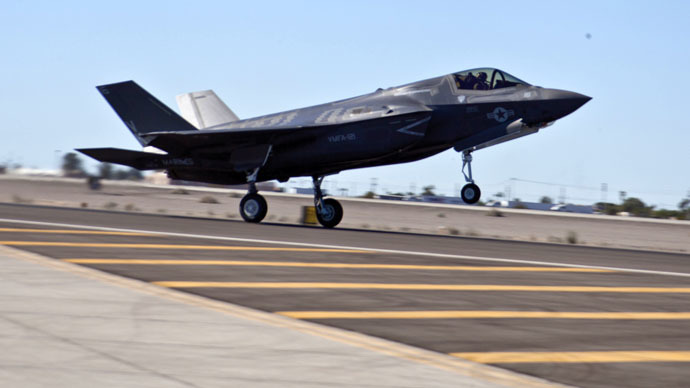But does it fly? Government auditors blast poor F-35 engine performance

The F-35 might be the Pentagon’s premiere cutting-edge fighter jet, but its engines are so unreliable the whole project may prove to be unaffordable unless performance improves, recent government audits have concluded.
The Department of Defense’s (DOD) Inspector-General blasted the program for 61 “nonconformities” documented during their inspection, saying that “additional program management oversight is required.”
Pratt & Whitney, the engine manufacturer, “had an outdated software development plan, requirements traceability issues, and a software quality assurance organization that did not perform required functions,” the Inspector-General wrote.
New Report: F-35 Engine Quality Assurance Inspection http://t.co/OWO34inlyR
— DoD InspectorGeneral (@DoD_IG) April 27, 2015
This comes following two reports by the Government Accountability Office (GAO), released this month, calling the F-35’s engine performance “very poor” and questioning the projected expenses of the current procurement program in light of more problems being expected to arise.
“Engine reliability is poor and has a long way to go to meet program goals,” said one GAO report, adding, “With nearly 2 years and 40 percent of developmental testing to go, more technical problems are likely. Addressing new problems and improving engine reliability may require additional design changes and retrofits.”
The “consistent changes” in procurement plans for the F-35 indicate that previous analyses by the Department of Defense’s “did not adequately account for future technical and funding uncertainty,” the GAO report states.
MT "Thrust You Can Trust"??? Is P&W F-35 engine reliability shortfall hindering F-35 aircraft deployment? https://t.co/ODNX2ol6il
— Wayne McCandless (@w_mccan) April 27, 2015
A separate report on the progress of the F-35 program noted that, while Lockheed Martin delivered 36 aircraft in 2014, as planned, “none of these were delivered with warfighting capabilities.”
READ MORE: US to deliver F-35 jets to Israel to maintain military edge
According to the GAO and Pentagon auditors, engines on the Air Force and Navy models of the F-35 flew about 25 hours between failures, instead of the 120 hours planned. The Marine Corps’ model performed slightly better, flying about 47 hours between failures caused by engine design issues, instead of the projected 90 hours.
Matthew Bates, a spokesman for Pratt & Whitney, told Bloomberg Business that the Marine Corps model’s reliability “is at 71 percent of where it is expected to be” and “has made consistent improvement progress” since 2013, while the Air Force model’s engine “is at 147 percent of where it is expected at this point.”
“While the report lists some propulsion concerns,” the Pentagon has “validated our reliability performance,” Bates said.
READ MORE: Pentagon’s F-35 stealth fighter jet has a 'brain' problem
Earlier this month, the House of Representatives’ Armed Services Committee learned that the jet’s software maintenance system gives false-positive readings 80 percent of the time. The Autonomic Logistics Information System (ALIS) is meant to flag issues with the plane so that maintenance teams can repair them, but Air Force Lt. Gen. Christopher Bogdan told lawmakers it still “has a long way to go.”












